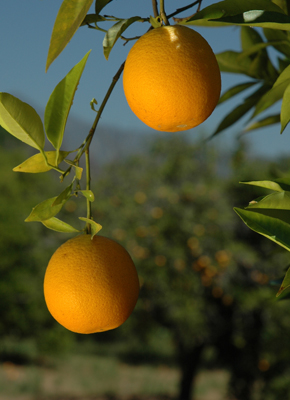The Huntington’s blog takes you behind the scenes for a scholarly view of the collections.
MR. HUNTINGTON'S GARDEN | When Life Gives You Lemons, Protect Them
Posted on Fri., May 6, 2011
How many of us know about huanglongbing (HLB), a.k.a. citrus greening disease? Not so many, most likely. Plant diseases can be a "so what" kind of thing. But how many of us will miss oranges, lemons, and limes if they completely disappear from our diets? I would wager quite a few.
This week we had a visit from two agents from the California Department of Food & Agriculture's (CDFA) Plant Health and Pest Prevention Services/Pest Detection Emergency Projects field office. They were here to check our orange groves for any evidence of Asian citrus psyllids, and we are glad for their monitoring. Entire task forces from the USDA and the CDFA are on the lookout, because these insects are spreading throughout the world. And time after time, within a few years of the first appearance of this psyllid, the disease it carries becomes evident. Just as mosquitoes transmit malaria, the psyllid transmits (or is the "vector" for, in agricultural parlance) a bacterial disease that infects citrus—all citrus and citrus relatives. Infected trees cannot be treated (at least there is no treatment so far) and have to be destroyed. A quarter of Florida citrus orchards have been lost since the disease first became apparent in September 2005, and the remainder seems doomed. One by one, every major citrus-producing region in the world is being devastated, and the watch is on for California.
You might wonder how a tiny psyllid (less than four millimeters long) can cross a desert, or an ocean. It is tempting to think the insect will ride in on huge agricultural shipments of live trees, or fresh fruit. But this insect seems to appear in urban areas first, moving into adjacent orchards. Experts speculate the psyllids travel in personal baggage or small parcels, when people might bring in a few fresh leaves (or even a small plant) of Kaffir lime or curry leaf for cooking their favorite foods. So Asian citrus psyllids have begun to show up in Los Angeles County—none has been found at The Huntington yet. But it is really just a matter of time; they are already in the area. The agriculture agents are diligent, and so far none of the psyllids located have proven positive for the bacterial disease, but the history in other zones is disheartening.
So what will we do here at The Huntington? I do not like to contemplate the prospect of eliminating every citrus plant from the Gardens, but if the disease arrives, there is no obvious alternative at this point. This is why we need to keep in touch with our friends in the various departments of agriculture; we want to stay up to date on any developments. It is also the reason people should resist the temptation to transport uninspected plants into Southern California. Now that the psyllid is present in the region, one plant infected with the disease (or one insect carrier) can change our landscape and culinary pleasure in just a few years.
If this sounds dire, it is by no means a single example. Look around town. Oleander, a plant we had come to consider bullet-proof, is dying back everywhere. It is disappearing from our landscapes, failing victim to a bacterial blight that operates somewhat like HLB. The disease has a vector, in this case it is a famous insect called the glassy-winged sharpshooter—the same insect that most effectively spreads Pierce's disease in grape vineyards. Once an oleander is infected, the plant begins to die back and will not recover.
The message is huge. We garden in a dynamic landscape and must be informed caretakers.
Jim Folsom is the Telleen/Jorgensen Director of the Botanical Gardens at The Huntington.
